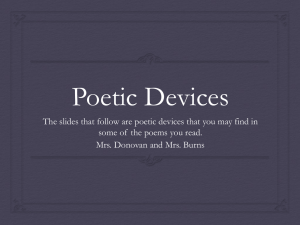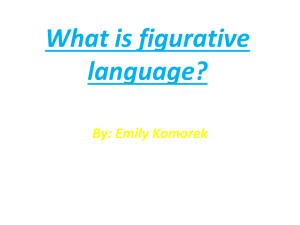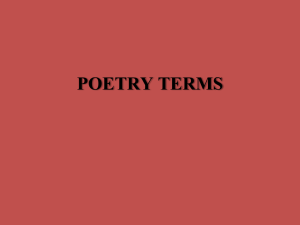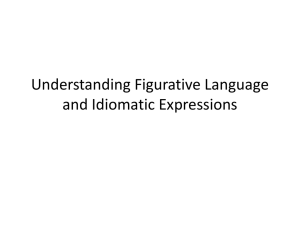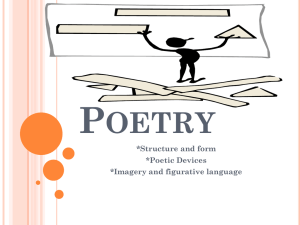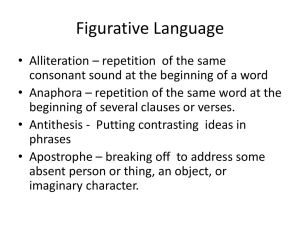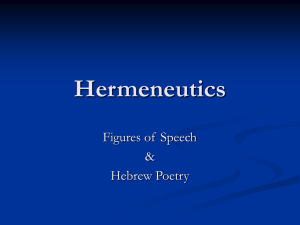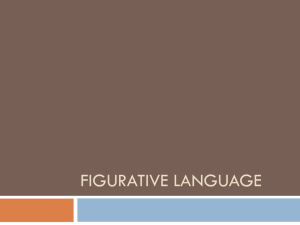Elements of Poetry
advertisement
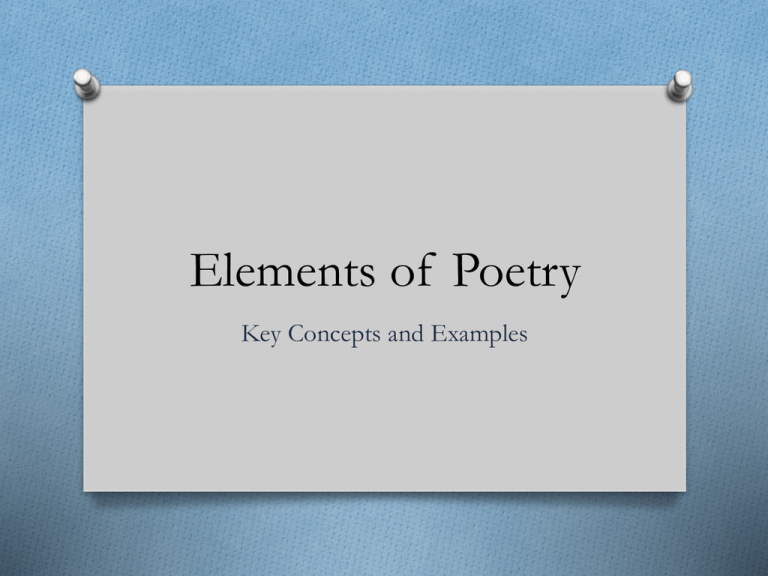
Elements of Poetry Key Concepts and Examples What is poetry? O No single definition O Most concentrated and condensed form of literature O Intense focus on each word and line and how they operate together to communicate experiences O Focus on communicating experiences O No lesson or moral required O Not always beautiful Where do we begin? O Denotation vs. Connotation O Literal meaning vs. Figurative meaning O Figures of speech and figurative language O Sound devices and musicality O Rhythm and meter O Tone and Theme What do words mean? O Denotation O Dictionary definition of a word; literal meaning O Connotation O Implied or suggested meaning of a word O Depends upon implication or shared emotional association O Example: O “Greasy” has a negative connotation, independent of dictionary definition Literal meaning vs. figurative meaning O Literal Meaning O The simplest, most obvious meaning O Tied to denotation of words O “The sky is gray” tells the color of the sky. O Figurative Meaning O Associational or connotative meaning O Tied to representations, symbolic meaning O “The sky is gray” suggests an ominous, foreboding atmosphere. Why are connotation and figurative meaning important? O Poems do not have only a literal meaning, but they have deeper meanings tied to their connotative or figurative meaning O Poets use connotations to develop or complicate a poem’s meaning O William Carlos Williams, “The Red Wheelbarrow” O Ezra Pound, “In a Station of the Metro” What is figurative language? O Language that cannot be taken literally or only literally O Language that employs figures of speech O Figures of speech – ways of saying something other than the ordinary way, where you say one thing and mean another O Examples: “It’s raining cats and dogs” or “I could eat a horse” Types of figurative language O Simile O A comparison of two essentially unlike things using “like” or “as” O Wordsworth, “I Wandered Lonely as a Cloud” O Metaphor O A comparison of two essentially unlike things without using words; application of a name or description to something to which it is not literally applicable O Literal and figurative terms may be named or implied O Ezra Pound, “In a Station of the Metro” Types of Figurative Language O Personification O Giving the attributes of a person to an animal, object, or concept O Tennyson, “The Eagle” O Apostrophe O Addressing someone absent or dead or something nonhuman as if that person or thing were present and alive O Angelou, “Woman Work” Types of Figurative Language O Hyperbole O Overstatement, exaggeration in the service of truth O Tennyson, “The Eagle”; Wordsworth, “I Wandered Lonely as a Cloud” O Understatement O Saying less than one means O Hayden, “Those Winter Sundays”; Hardy, “The Man He Killed” Types of Figurative Language O Symbol O Something that means, suggests more than what O O O O it is Functions both literally (what the symbol is) and figuratively (what the symbol represents) Yeats, “The Lake Isle of Innisfree” Hayden, “Those Winter Sundays” Wordsworth, “I Wandered Lonely as a Cloud” What is the relationship between symbols and similes/metaphors? O Similes and metaphors compare two seemingly unlike things O “Some dirty dog stole my wallet” O Symbols associate two things using literal and figurative meaning O “You can’t teach an old dog new tricks” Types of Figurative Language O Paradox O A seeming contradiction that is somehow true O Valuable for shock effect, attracts attention O Example: “Poetry is a language that tells us, through a more or less emotional reaction, something that cannot be said.” Edwin Robinson O Example: “Cowards die many times before their deaths; / The valiant never taste of death but once.” Shakespeare Types of Figurative Language O Irony O When you say or get the opposite of what you mean or expect O Verbal irony – discrepancy between what the speaker says and what the speaker means O Dramatic irony – discrepancy between what the speaker says and what the poem means O Owen, “Dulce et Decorum Est” O Brooks, “We Real Cool” Types of Figurative Language O Pun O A play on words; a humorous use of a single word or sound with two or more implied meanings O Oxymoron O A compact paradox in which two successive words seemingly contradict one another O Examples: bittersweet, wild civility, cold heat Types of Figurative Language O Metonymy O The use of something closely related for the thing actually meant O Example: “The pen is mightier than the sword” O Synecdoche O A part substituted for the whole O Yeats “The Lake Isle of Innisfree” What poetic elements exist? O Imagery O Words or sequence of words that represent a sensory experience (sight, smell, hearing, taste, touch) O Collins, “Introduction to Poetry” and nearly all poems What poetic elements exist? O Allusion O A reference to something in history or previous literature O Hopkins, “Spring” O Yeats, “No Second Coming” What sound devices exist? O Alliteration – repetition of initial consonant sounds O Assonance – repetition of vowel sounds O Consonance – repetition of final consonant sounds O Onomatopoeia – use of words to imitate the sounds they describe What sound devices exist O Rhyme – repetition of accented vowel sounds and any succeeding consonant sounds O Internal rhyme – one or more rhyming words within single line O End rhyme – rhyming words at end of line O Approximate rhyme – slant rhyme, words with any kind of sound similarity (alliteration, assonance, and consonance at end of lines) What sound devices exist? O Elision – omission of unstressed vowel or syllable to preserve meter O Anaphora – repetition of opening word of phrase in a series of lines (Angelou, “Woman Work”) O Refrain – repetition of whole words, phrases, lines, or groups of lines according to fixed pattern (Shakespeare, “Winter”) What is meter? O Meter – measured pattern of rhythmic accents in a line of verse O Foot – basic unit of meter, consisting of one accented syllable plus one or two unaccented syllables O Iambic (iamb) – metrical foot containing two syllables, first unstressed, second stressed O Iambic pentameter – five iambic feet What is rhythm? O Rhythm – natural rise and fall of language O Corresponds to alternation between accented (stressed) and unaccented (unstressed) syllables O End-stopped line – end of the line corresponds with natural speech pause O Run-on line – no natural pause at end of the line; enjambment O Caesura – a pause for a beat in the rhythm of the verse (within a line) What poetic forms exist? O Open vs. Closed O Open – free from regularity and consistency O Closed – follows fixed structure and pattern (rhyme, length, meter) O Blank verse vs. Free verse O Blank verse – unrhymed iambic pentameter (Shakespeare’s plays) O Free verse – no prescribed pattern or structure What poetic forms exist? O Stanza – unit of poetic lines, verse paragraph O Couplet – a pair of lines, usually rhymed O Heroic couplet – pair of rhymed lines in iambic pentameter O Sonnet O 14 lines, iambic pentameter, prescribed rhyme O English (Shakespearean) sonnet: abab cdcd efef gg O Italian (Petrarchan) sonnet: abbaabba cdecde OR cdcdcd Tone and Subject O Tone O The writer’s or speaker’s attitude toward the subject, the reader, or herself of himself O Subject O What is the poem about? Meaning vs. Theme O Poem’s meaning – the experience it expresses O What experience does the poem communicate, and how well does it do so? O Poem’s theme O The central idea or unifying generalizations implied or stated by a literary work O Ascertain from the poem itself O Not simply the subject of the poem, but what does the poem suggest about a subject How do we approach poems? O Six Steps O Read aloud twice – define unknown words – initial impressions, responses, observations – TPCASTT analysis – return to initial impressions, responses, observations – evaluate the poem O TP-CASTT O Title – Paraphrase – Connotations – Attitude – Shifts– Title – Theme


